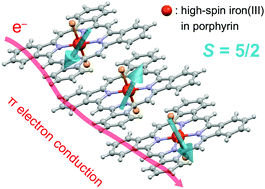An electrically conducting crystal composed of an octahedrally ligated porphyrin complex with high-spin iron(iii)†
Abstract
A porphyrin-based octahedrally ligated complex with high-spin iron(III) was designed, and the resulting electrically conducting crystal TPP[FeIII(tbp)Br2]2 (TPP = tetraphenylphosphonium and tbp = tetrabenzoporphyrin) was synthesised. Although TPP[Fe(tbp)Br2]2 was isostructural to the reported TPP[Fe(Mc)L2]2 systems (Mc = macrocyclic ligands such as phthalocyanine (Pc) or tbp; and L = CN, Cl, or Br), the bond lengths between Fe and ligands in the [Fe(tbp)Br2] unit were evidently longer than those in the other units, because of the different spin states of Fe: high-spin in TPP[Fe(tbp)Br2]2 and low-spin in others. The magnetic anisotropy observed in the low-spin state vanished when the Fe is in the high-spin state. Based on reports for Pc-based systems, the negative magnetoresistance (MR) effect for TPP[Fe(tbp)Br2]2 was expected to be smaller than that for TPP[Fe(tbp)(CN)2]2. However, the former showed a giant negative MR effect similar to or larger than the latter, suggesting that the nature of iron is a crucial factor for the electrical properties of porphyrin-based materials.



 Please wait while we load your content...
Please wait while we load your content...